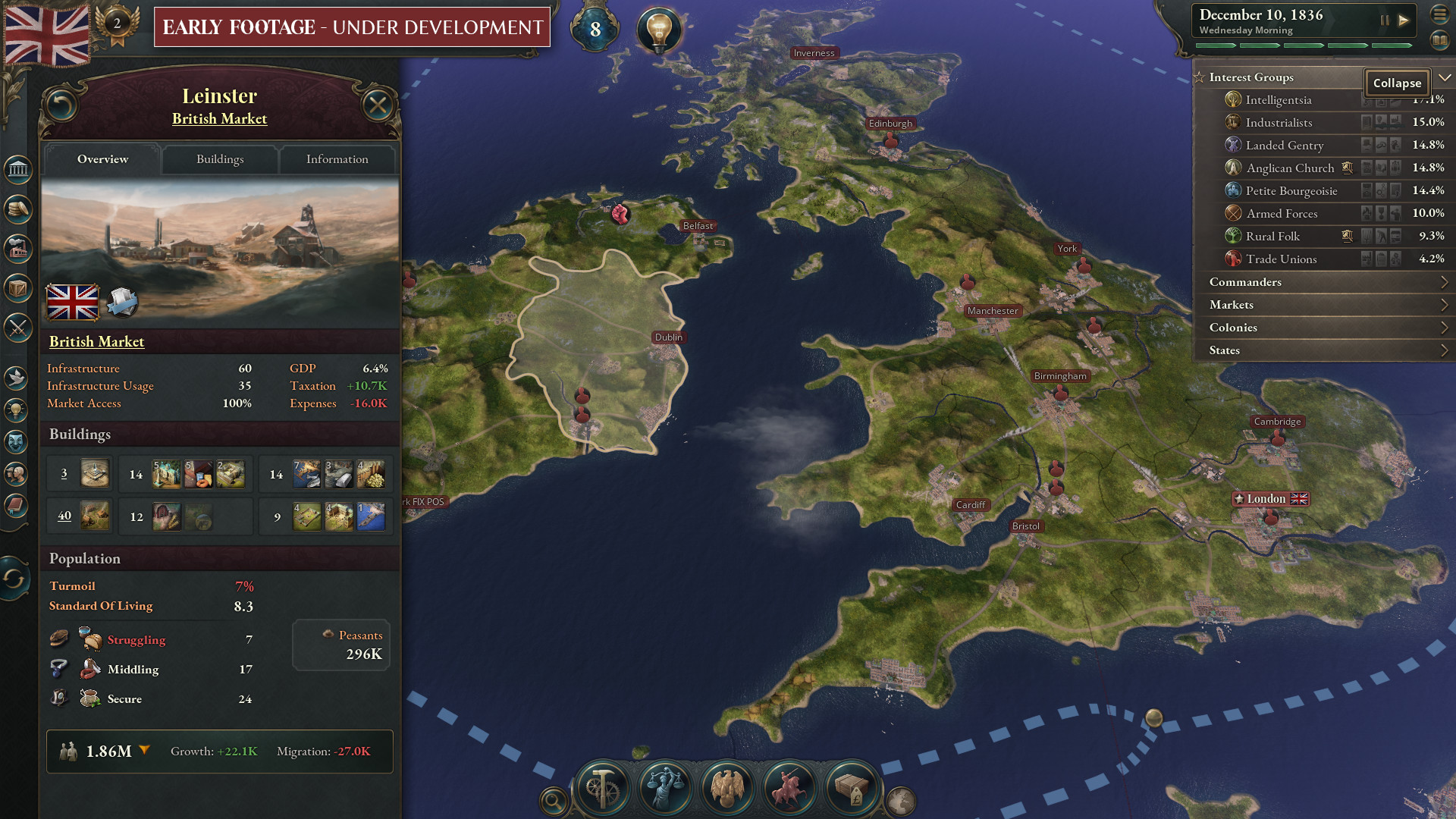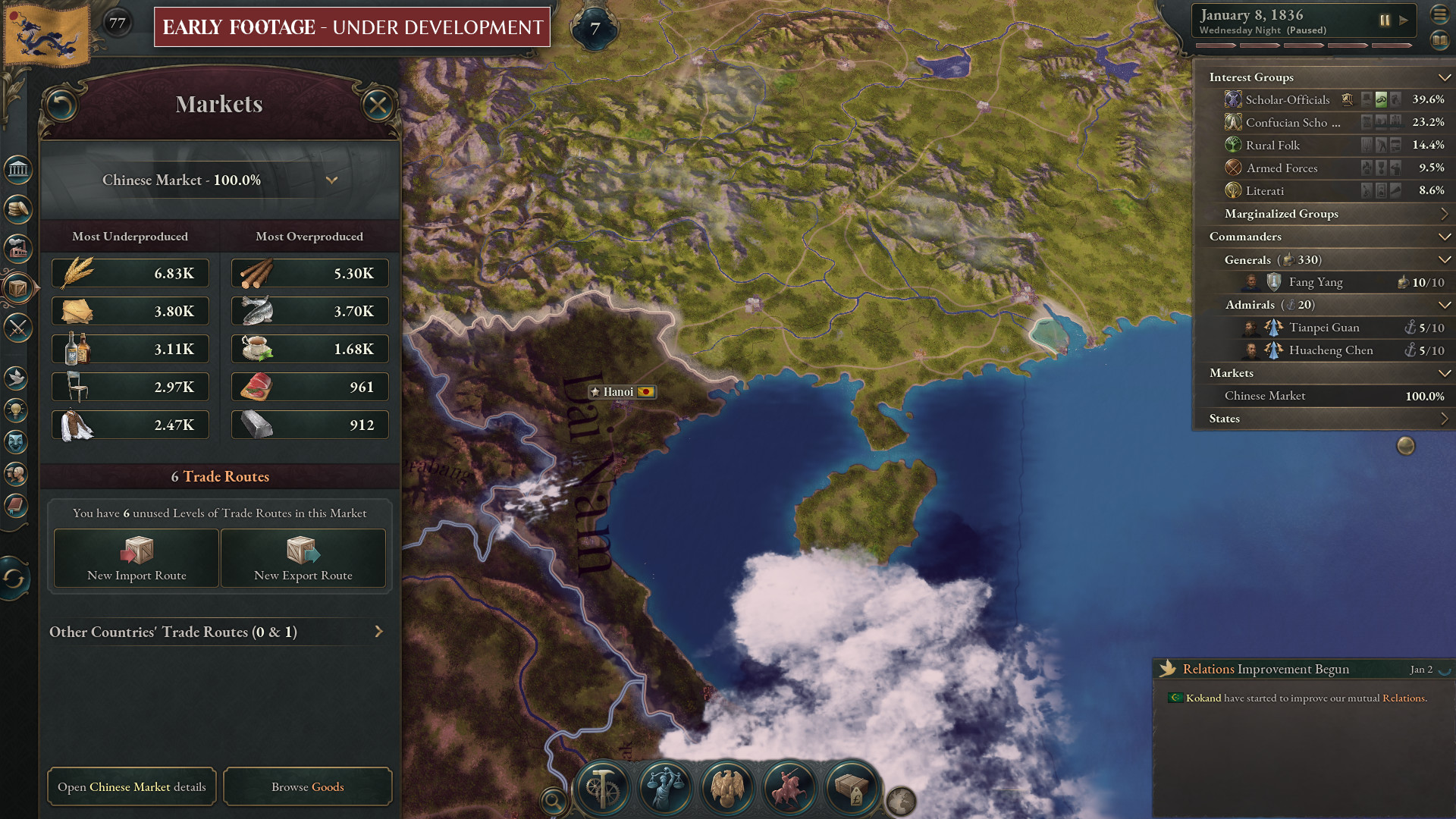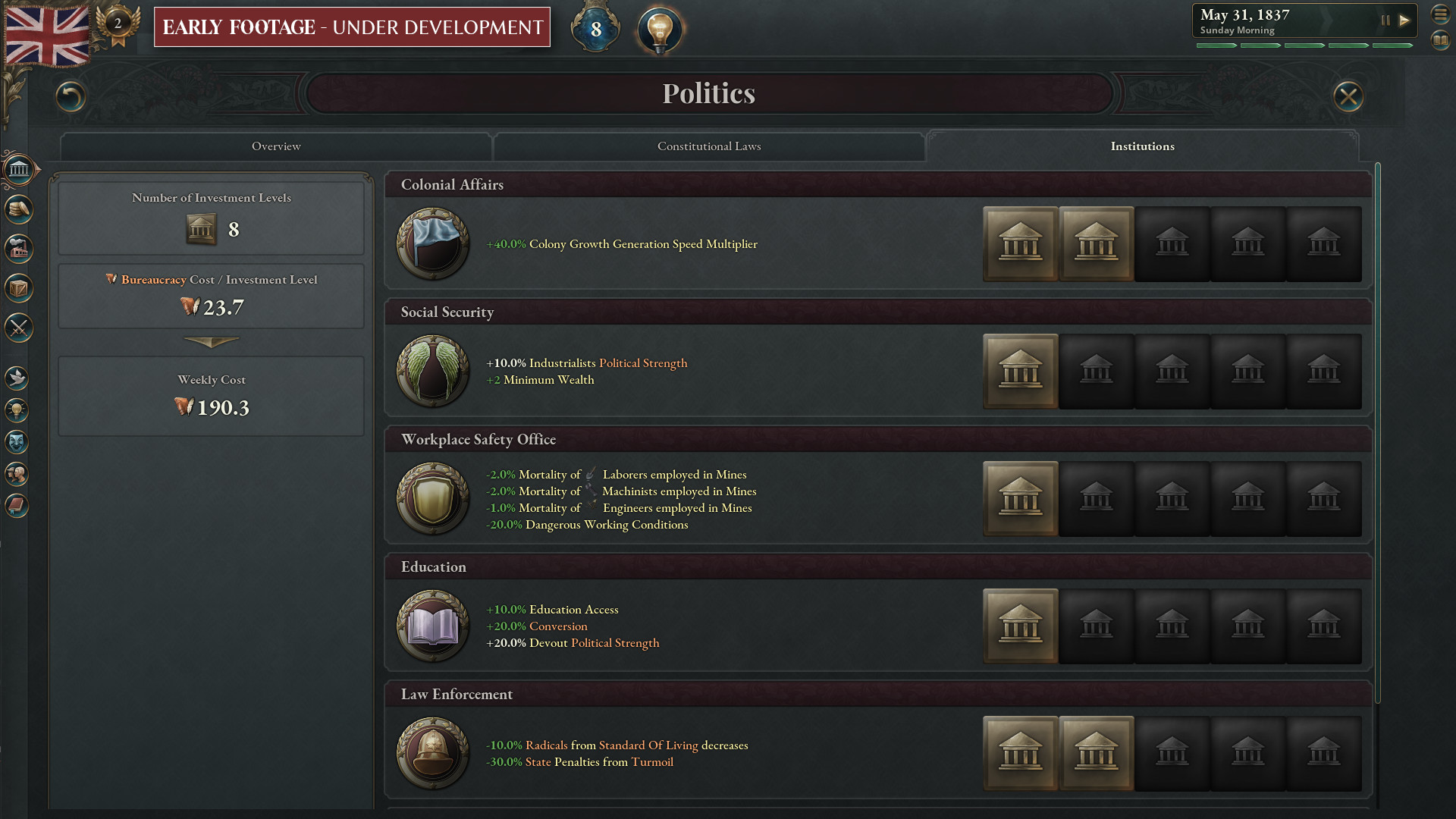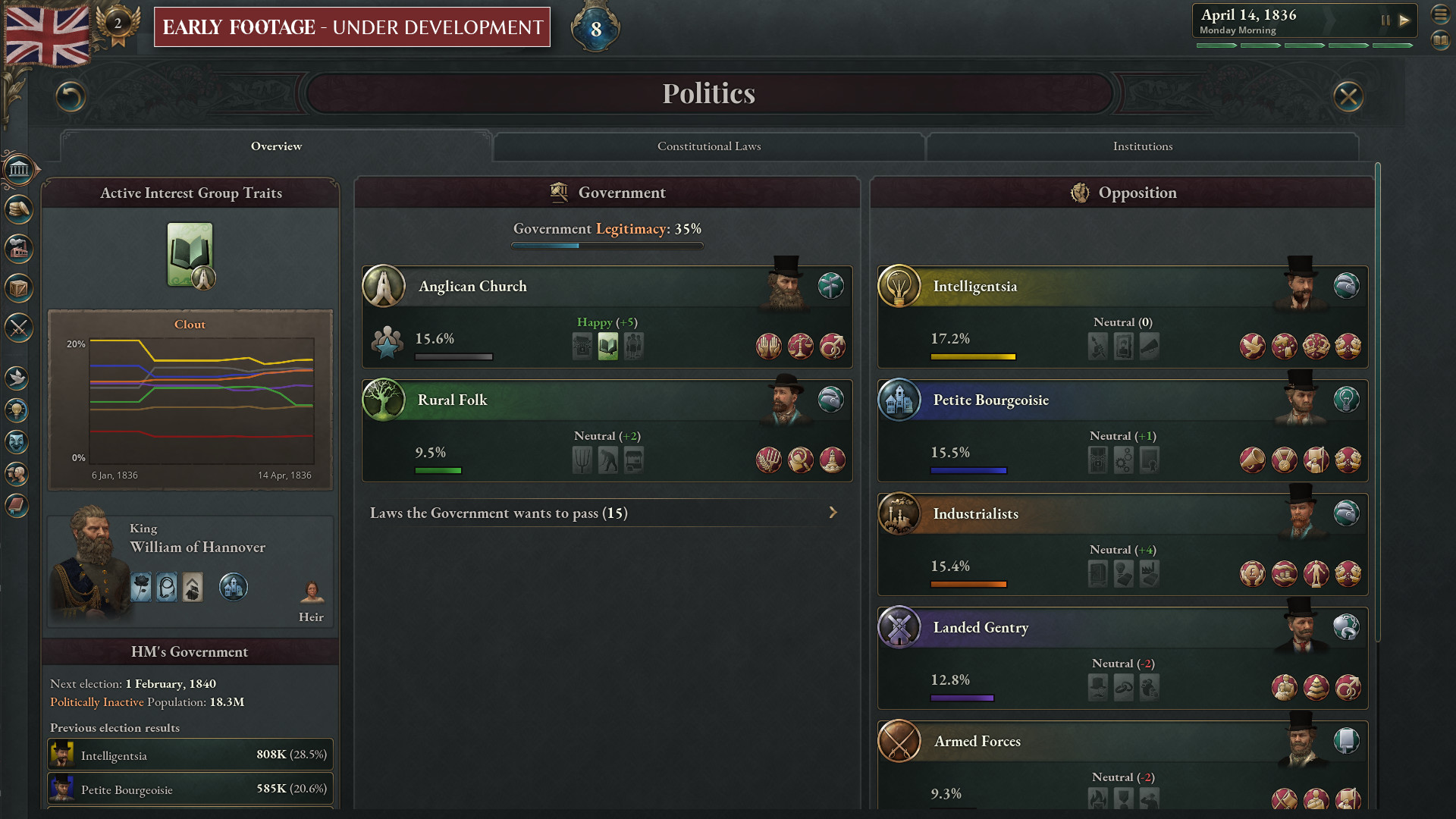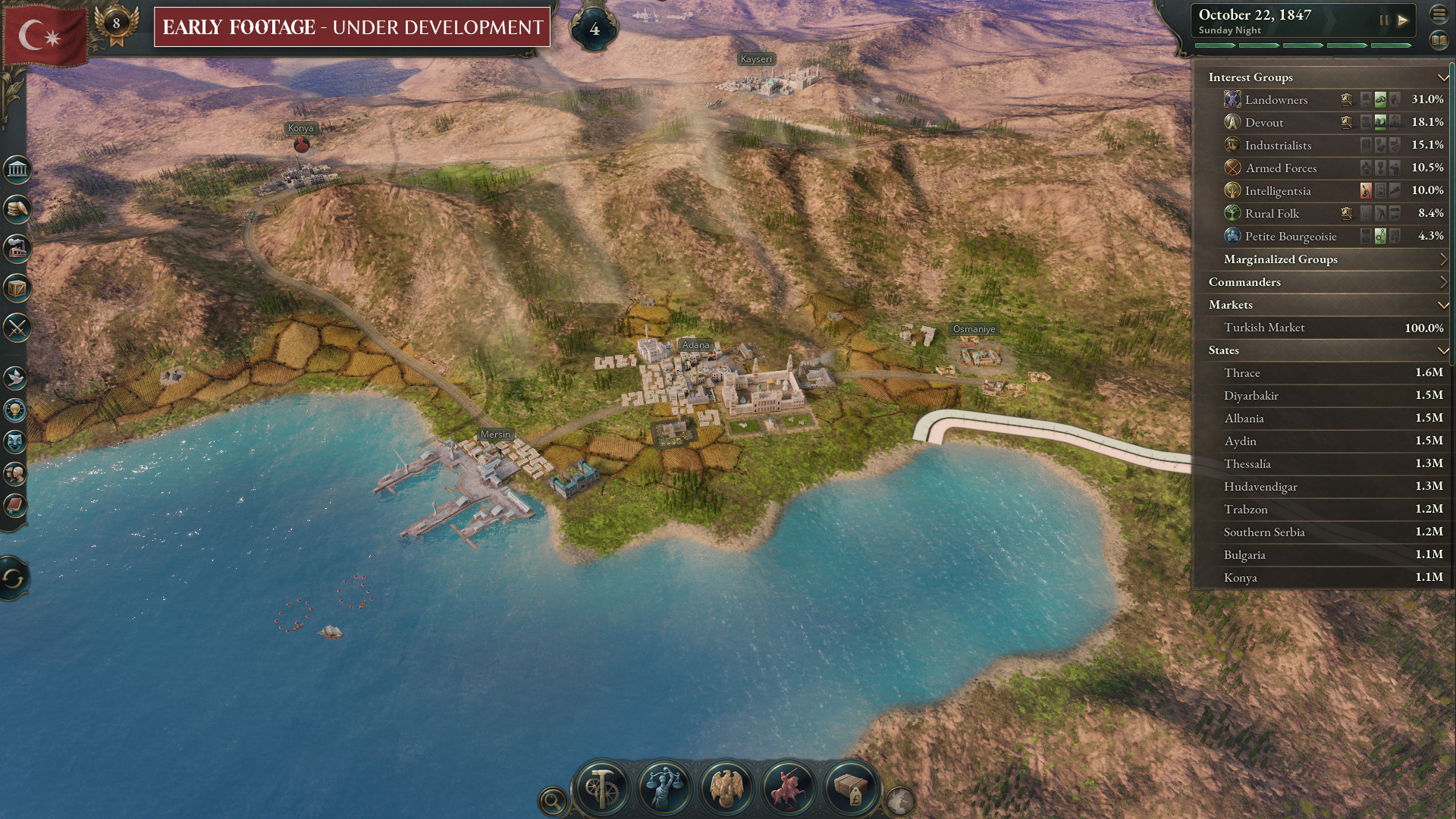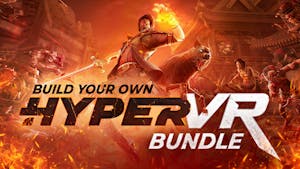SHAPE A GRAND TOMORROW
Paradox Development Studio invites you to build your ideal society in the tumult of the exciting and transformative 19th century. Balance the competing interests in your society and earn your place in the sun in Victoria 3, one of the most anticipated games in Paradox’s history.THE ULTIMATE SOCIETY SIMULATOR
- Lead dozens of world nations from 1836-1936. Agrarian or Industrial, Traditional or Radical, Peaceful or Expansionist... the choice is yours.
- Detailed population groups with their own economic needs and political desires.
- Reform your government and constitution to take advantage of new social innovations, or preserve the stability of your nation by holding fast to tradition in the face of revolutionaries.
- Research transformative new technology or ideas to improve your national situation.
DEEP ECONOMIC SYSTEM
- Expand your industry to take advantage of lucrative goods, taxing the profits to improve national prosperity.
- Import cheap raw materials to cover your basic needs while finding new markets for your finished goods.
- Secure vital goods to fuel your advanced economy and control the fate of empires.
- Balance employing available labor force with the needs for new types of workers.
PLAY ON A GRAND STAGE
- Use your diplomatic wiles to weave a tangled global web of pacts, relations, alliances, and rivalries to secure your diplomatic position on the world stage.
- Employ threats, military prowess and bluffs to persuade enemies to back down in conflicts.
- Increase your economic and military strength at the expense of rivals.
- Accumulate prestige and the respect of your rivals as you build an industrial giant at home or an empire abroad.

Happy Thursday and welcome back to our series of development diaries on warfare in Victoria 3! Today we talk about navies, and how we intend to make them as strategically important to winning wars as they were in history. This diary builds on the warfare vision presented in The Concept of War and many of the core mechanics presented in Fronts and Generals , so ensure those are fresh in your mind before reading on!
Your ability to sustain an empire depends, to a large extent, on how well you can compete on the high seas. This is the era of truly global trade, which also meant countries were highly susceptible to disruption of that trade - and the higher they climb, the harder they may fall. In Victoria 3, maintaining a powerful blue-water navy is a large but necessary expense if you wish to ensure the integrity of your markets, overseas colonies, and trade routes during war. And even while at peace, a magnificent fleet can provide your nation with substantial Prestige!
Our design intent for naval gameplay in Victoria 3 is that it should serve as a strategic precision instrument in conflicts between seafaring nations. The sea is not another front in a war. The province-based moving Front system works well to represent conflicts over territory but would be nonsensical at sea, where no nation can be said to meaningfully control an enormous stretch of ocean. Instead, Admirals and their Flotillas are deployed to meet specific strategic objectives to disrupt the enemys military operations or economy, or defend against such attempts by the enemy. A powerful navy can never win you the war on its own, but if deployed correctly under the right circumstances it can be the ace in the hole that lets you outsmart even a foe thats superior on paper.
A clipper departing Luanda in the Portuguese colonial state of North Angola, representing the colonys connection to the Market Capital in Lisbon.
As with land warfare and Generals, you control your navy through your Admirals. Generals and Admirals share many similarities. Both are provided with military resources originating from buildings in the Strategic Region they call home. The amount of resources they get depend on their Rank, which you can grant via promotions to reward your favorite commanders. Their Rank also lends Political Strength / Clout to the characters favored Interest Group. Furthermore, both Generals and Admirals get Traits that affect both themselves and those Officers and Servicemen serving underneath them.
Most importantly, just like Generals are your interface to command your armies, Admirals are the interface to your navies. Admirals are given Orders, which they attempt to carry out to the best of their ability using the Flotillas they have been assigned. These Orders consist of:
Intercept any hostile navies around a certain Strategic Regions friendly coastlines while keeping your fleets stationed close to shore
Patrol any shipping lanes between the Admirals home region and a remote region, intercepting any hostile navies encountered
Convoy Raid at a particular point at sea to damage enemy shipping lanes
Naval Invasion to establish a beachhead and a frontline on enemy soil, by escorting and protecting a Generals land forces in a joint operation
While it has not yet made its way into the game, we also want to add a fifth Order - Blockade - to disable enemy ports and prevent hostile forces from crossing straits.
An artistic mockup of an Admiral in the Navy panel. Admiral Ruiz and his 10 Flotillas are currently on Interception duty in the Iberia HQ, ensuring no Naval Invasions or Blockades endanger the Spanish home front.
Convoy Raid and Naval Invasion are aggressive orders intended to hurt the enemy in different ways, while Intercept and Patrol are defensive orders that counter the other two. But to really understand how these work we have to start by talking about Shipping Lanes and the Supply Network.
Shipping Lanes are facilitated by vessels called Convoys, which are an output of Port buildings. These are created automatically whenever its necessary to move goods and/or people overseas. The three main reasons this happens are due to naval Trade Routes between non-adjacent markets, remote States connecting to their Market through a Port, and Battalions sent to frontlines that can only be supplied by ship. When a player is about to take an action that establishes such a shipping lane they are warned of how many new Convoys would be required for this action, which is based on the size of the route or the army supplied.
Shipping Lanes are always established via the shortest possible path, as defined by the number of nodes in the naval network it passes through.
A zoomed-out view of the North Angolan shoreline above, showing the main route ships travel off the coast of southeast Africa. The yellow pin indicates this path is part of Portugals Supply Network.
The sum total of a countrys Shipping Lanes determine the extent of its Supply Network, and the total cost in Convoys of that network compared to the Convoy output by Ports determine the overall strength of that network. That is to say, if the total Shipping Lane cost is 500 Convoys but Ports provide only 400, the Supply Network as a whole will operate at only 80% efficiency. This impacts all Shipping Lanes, causing less trade to flow between the markets than would be optimal and impacting the supply and morale of overseas troops.
Admirals assigned to Convoy Raid a given sea node will surreptitiously try to sink any enemy transports that pass through. In effect this will do damage over time to the affected Shipping Lanes, causing both an overall drop in efficiency of the affected countries Supply Networks but also a larger, local drop in efficiency of the damaged Shipping Lanes. As a result, by parking your fleet in a highly trafficked part of the ocean you could do a lot of damage to your enemys trade or even directly impact the amount of military supplies theyre able to send to their frontlines.
A very visually un-polished view of part of Portugals supply network, stretching from the Azores around the African continent all the way to Portuguese Bombay. In the lower-right corner we see an additional tendril going east, which is a trade route importing Porcelain from China.
Admirals assigned to Patrol a certain stretch of their Supply Network will eventually be able to detect and engage the raiding navy, causing a naval battle to ensue which will not only sink ships but also send the losing side back to base for repairs for some time. Admirals assigned to Intercept all nodes along a coastline are able to do the same to any raiders along the coast. Convoy Raiding right outside a major entry/exit port, such as in the English Channel, therefore has the chance to seriously disrupt a large number of shipping lanes but also put you at greater risk of detection and interception than if youre raiding transatlantic shipping lanes on the deep seas. The composition of your navy can also greatly impact how this plays out: a fleet with an accompaniment of Submarines can deal more damage before being intercepted, while a fleet of Monitors has an easier time intercepting raiders but may be more easily sunk if faced down by a more powerful navy.
Because the distance Admirals must patrol plays a difference, there is an inherent asymmetry to Convoy Raiding and Patrol orders. Since a chain is only as strong as its weakest link the damage done to a shipping lane by raiders is the same whether it stretches across 1 node or 10, whereas 10x as many Flotillas are needed to protect the longer route as effectively as the shorter.
Extremely unfinished breakdown of what is currently happening in the Macaronesian Sea. Look at all those juicy raiding targets!
Naval Invasion is an Order you give to provide naval support for a Generals landing on an enemy coastline. The size of the fleet determines two things: one, how great is the chance that youll be able to defeat an opponents intercepting fleet, and two, how many Battalions will you be able to successfully land. Even if the enemy has no defensive fleet at all, a naval invasion with a very small fleet might land too weak of an initial force to withstand the enemys counter-offense before the rest of the army can arrive. Since Naval Invasion is a one-time Order, once it has been completed it automatically turns into a Patrol Order to protect the shipping lane supplying the new Front.
Concept art of early Ship-of-the-Line and late-game Dreadnought class vessels
Navies are made up of Flotillas, which are constructed and maintained by Naval Bases. Naturally these can only be built on coastlines, where they consume military vessels such as Man-o-Wars or Ironclads constructed in Shipyards. Like Barracks they also employ Servicemen and Officers Pop, and depending on your navy configuration may need to consume other military goods as well (such as Ammunition and Radios) in order to keep in fighting condition. Flotillas differ from Battalions in how long it takes to create and upgrade them; constructing a competitive navy is not something you can begin considering when your rival has already started saber-rattling.
Another difference between Battalions and Flotillas is that your countrys navy is always considered to be in fully active service. In peacetime Generals can keep their troops on low alert, limiting their consumption and expenses. Once war breaks out, Generals can be selectively mobilized to only deploy the troops necessary. Admirals on the other hand have exorbitant needs and expenses even while at peace, so sizing and teching your navy appropriately is an important consideration for imperialists on a tight budget.
On the other hand, navies provide you with considerable Power Projection which confers substantial Prestige onto your country. Having a world-class navy is not strictly a requirement to be a Great Power, particularly if youre a large self-sustaining terrestrial empire, but it definitely helps you both gain and hold onto the title.
Artistic mockup of the Navy panel with Flotillas expanded. Admiral Alvarez de Toledo commands 20 Flotillas of Man-o-Wars on a Patrol mission to secure an important Spanish shipping lane.
Before we wrap up for this week, I want to say a few words about the lack of an order to just seek out and destroy enemy forces. In Victoria 3, your commanders - Generals as well as Admirals - are given strategic objectives which they use their manpower and resources to carry out as best they can. If in the process they get into conflict with the enemys forces (as they almost certainly will at some point) a battle will ensue. The outcome of that battle determines which direction the war proceeds in. The intent of this is to remove the need to babysit your commanders.
To illustrate this, assume we did have an order to seek and destroy. The optimal choice would then be to assign this order only to the strongest commander, fight the eventual battle, then revoke this order and give it to another commander while the first one recuperates, and so on.
With an order like advance front instead, the Generals intention is simply to capture territory as efficiently as possible, ideally while avoiding enemy interference. If its impossible to avoid the enemy, the imperative is to try to be intercepted by as weak of an enemy force as possible. Meanwhile the intent behind defend front is the opposite: prevent enemy incursions by defending it in the places where the enemy might advance, bringing to bear as powerful a force as possible. Similarly at sea, convoy raiding is about maximizing shipping lane damage while avoiding detection, while patrol is about minimizing damage to convoys by seeking out and destroying those enemy ships attacking them - not to sink ships for its own sake.
Depending on how the war is developing your priorities or overall strategy might certainly shift, causing you to change the orders youve assigned or make changes in your ranks to distribute resources differently. But our design intent is that this should only be necessary because your strategy is evolving, not to counter enemy movements or try to minmax your way to victory.
This is an especially important consideration for the naval part of the warfare mechanics. Naval (and aerial) warfare in strategy games commonly face the design challenge of extreme mobility options due to the lack of obstacles to movement. Usually some form of Fog of War and interception-radius mechanics is employed to counteract turtling behavior. The AI also often has to be forced to make mistakes to not become too good at dodging or intercepting the player in this environment. Even with Victoria 3s more strategic-level decision making, the freedom of movement the sea provides would make a system where being in/avoiding being in the same location as the enemy so as to start/not start a battle extremely micro-heavy, annoying, and highly unfair to either human or AI players depending on implementation.
So instead, in Victoria 3, you tell your Admirals what their overall priorities should be for the war and then they try to do that, using the resources theyve been allocated, only coming into conflict when they become aware of an enemy Admiral with an order that clashes with their own.
I hope that gives you a good idea of what to expect from the naval mechanics in Victoria 3. Next week we will wrap up this first batch of diaries on the military system by going through the many economic impacts of warfare in Victoria 3. Until then!
Minimum Setup
- OS: TBC
- Processor: TBC
- Graphics: TBCSound Card: TBC
Recommended Setup
- OS: TBC
- Processor: TBC
- Graphics: TBCSound Card: TBC
[ 6485 ]
[ 1519 ]
[ 2422 ]

